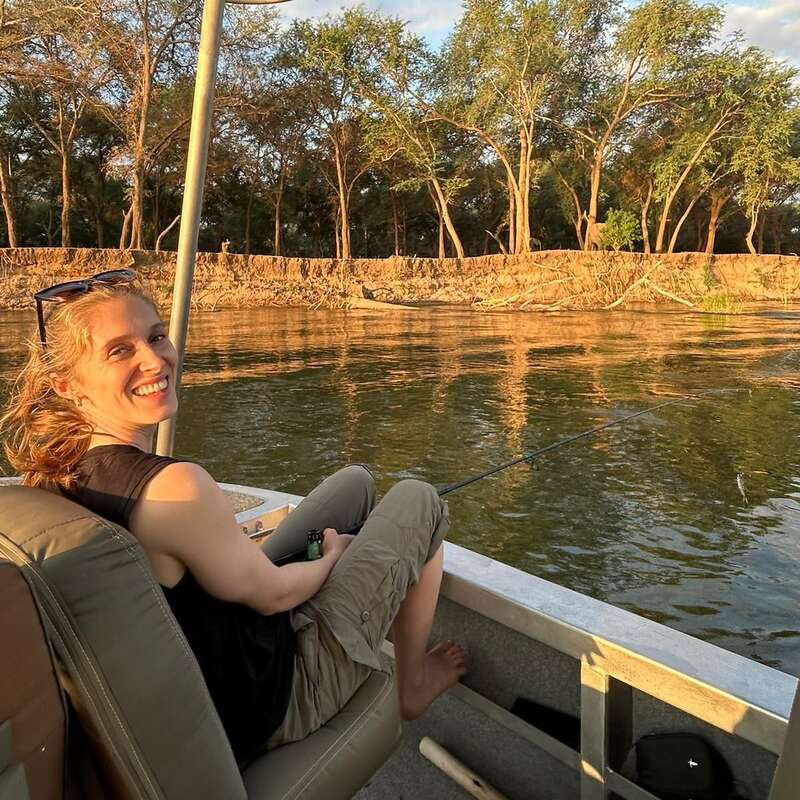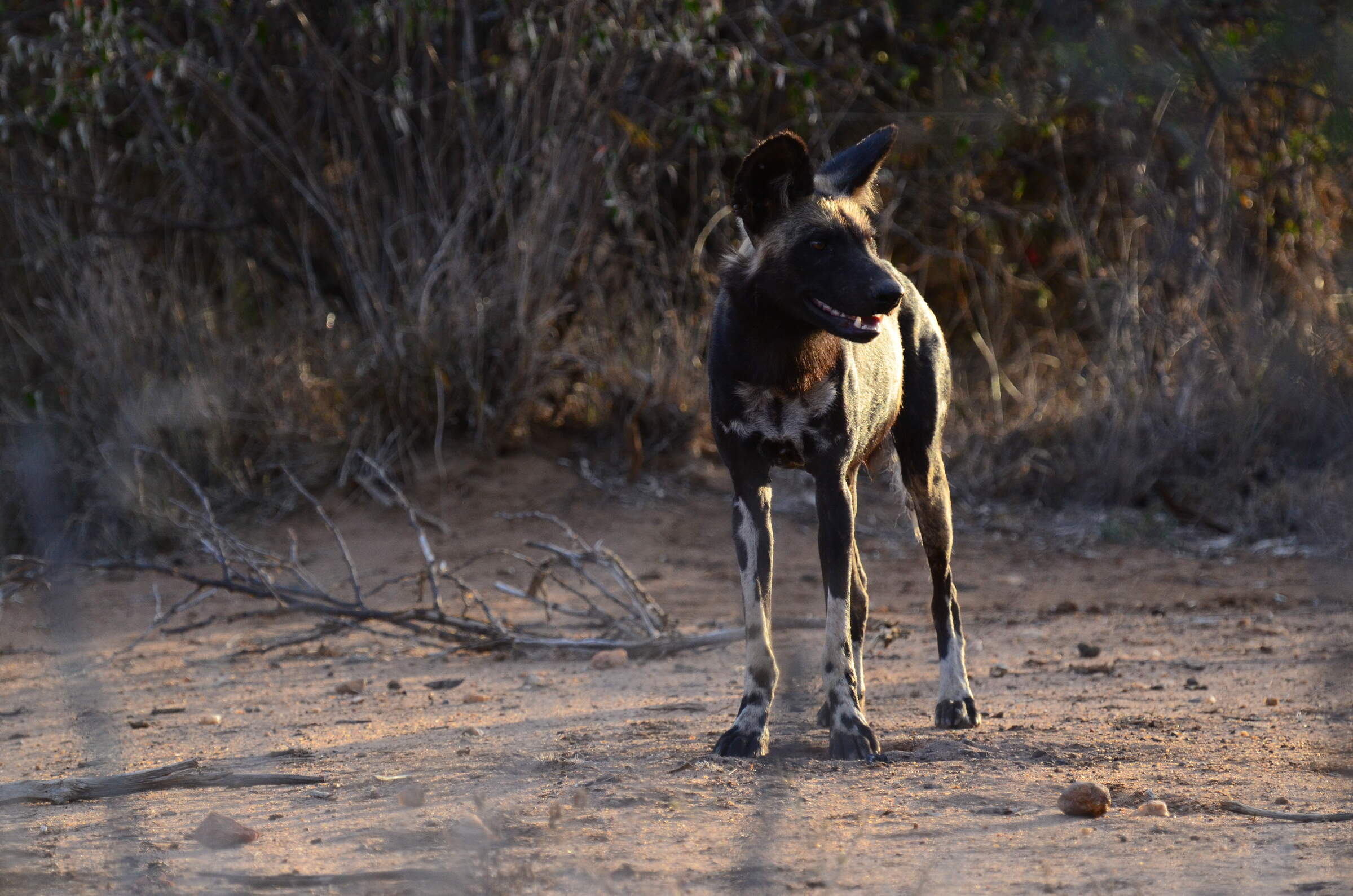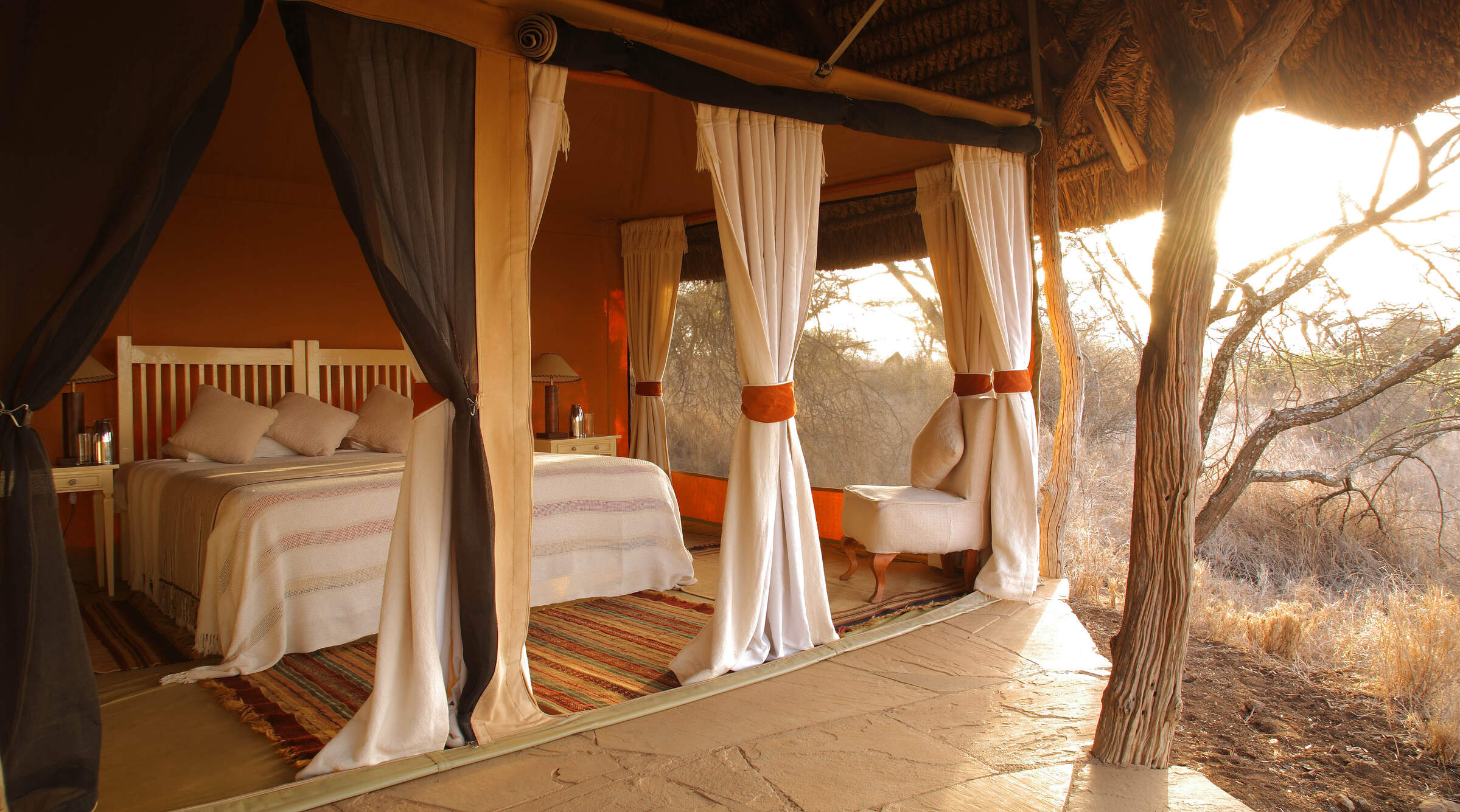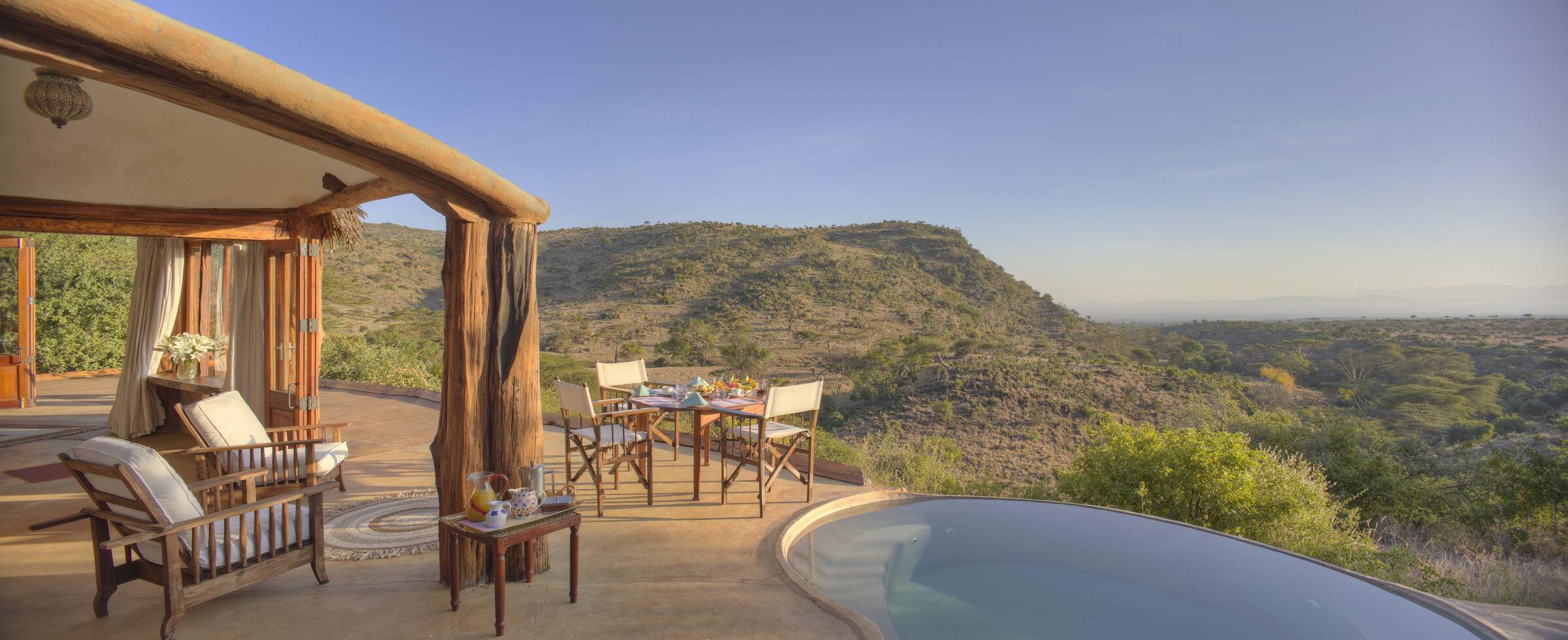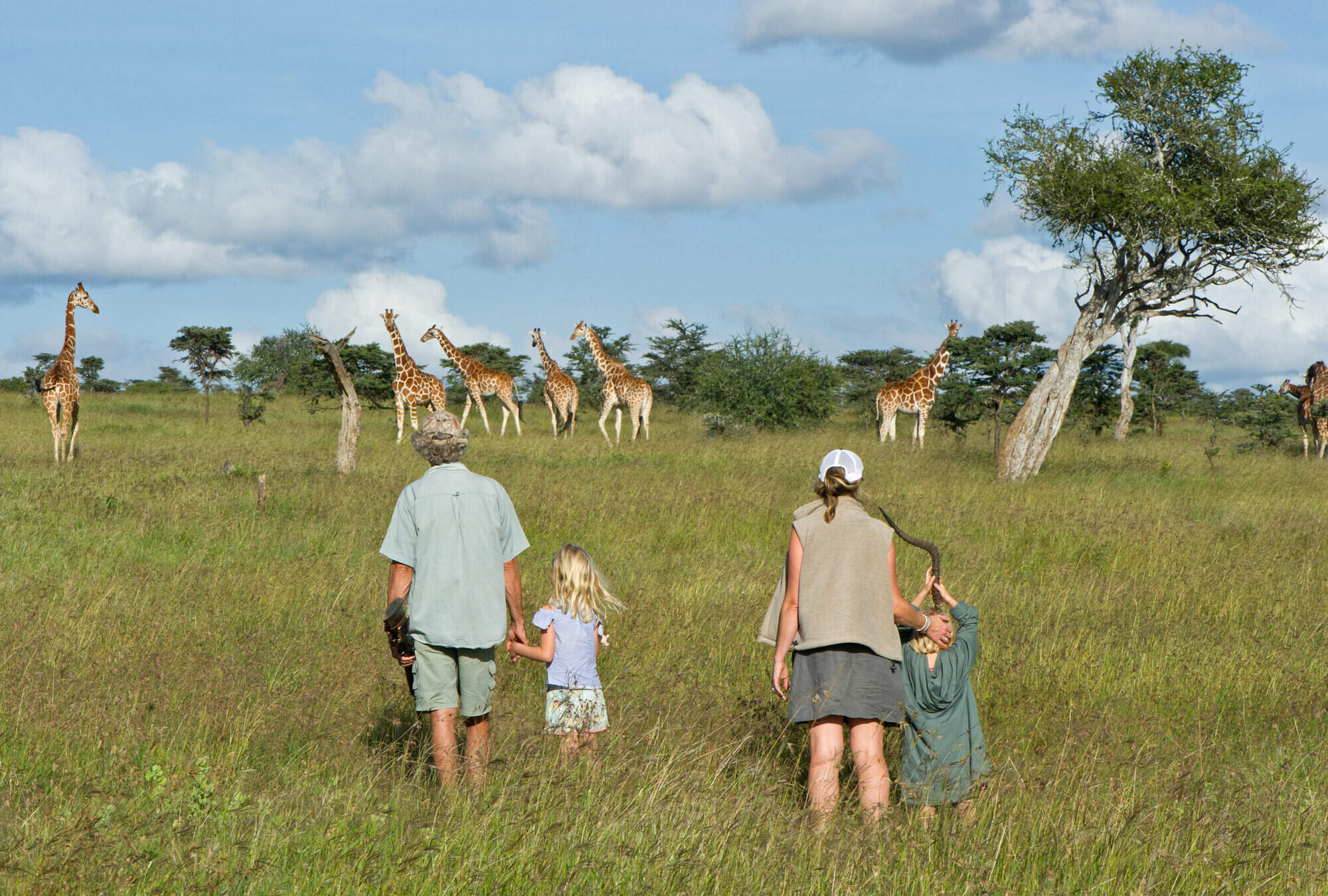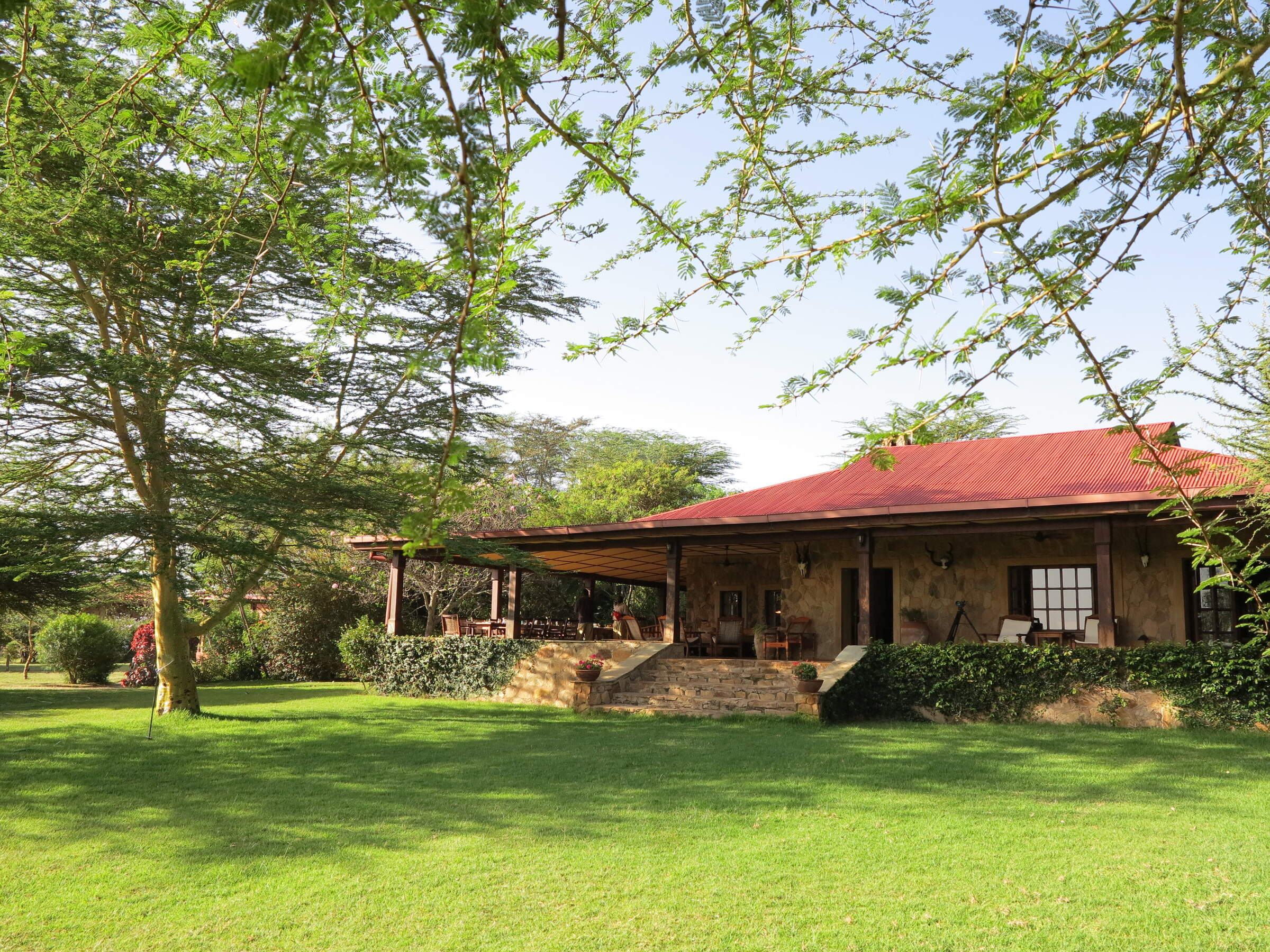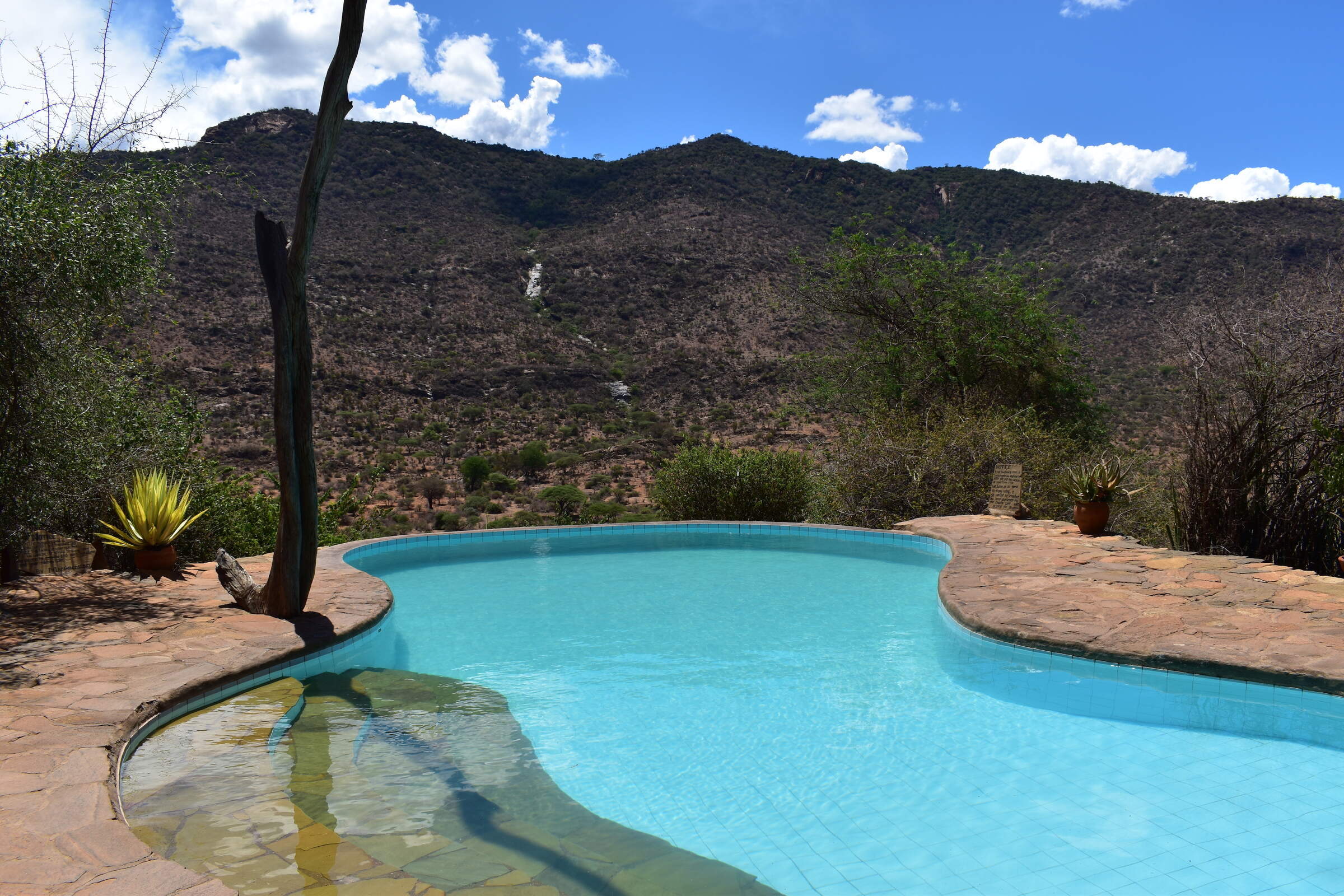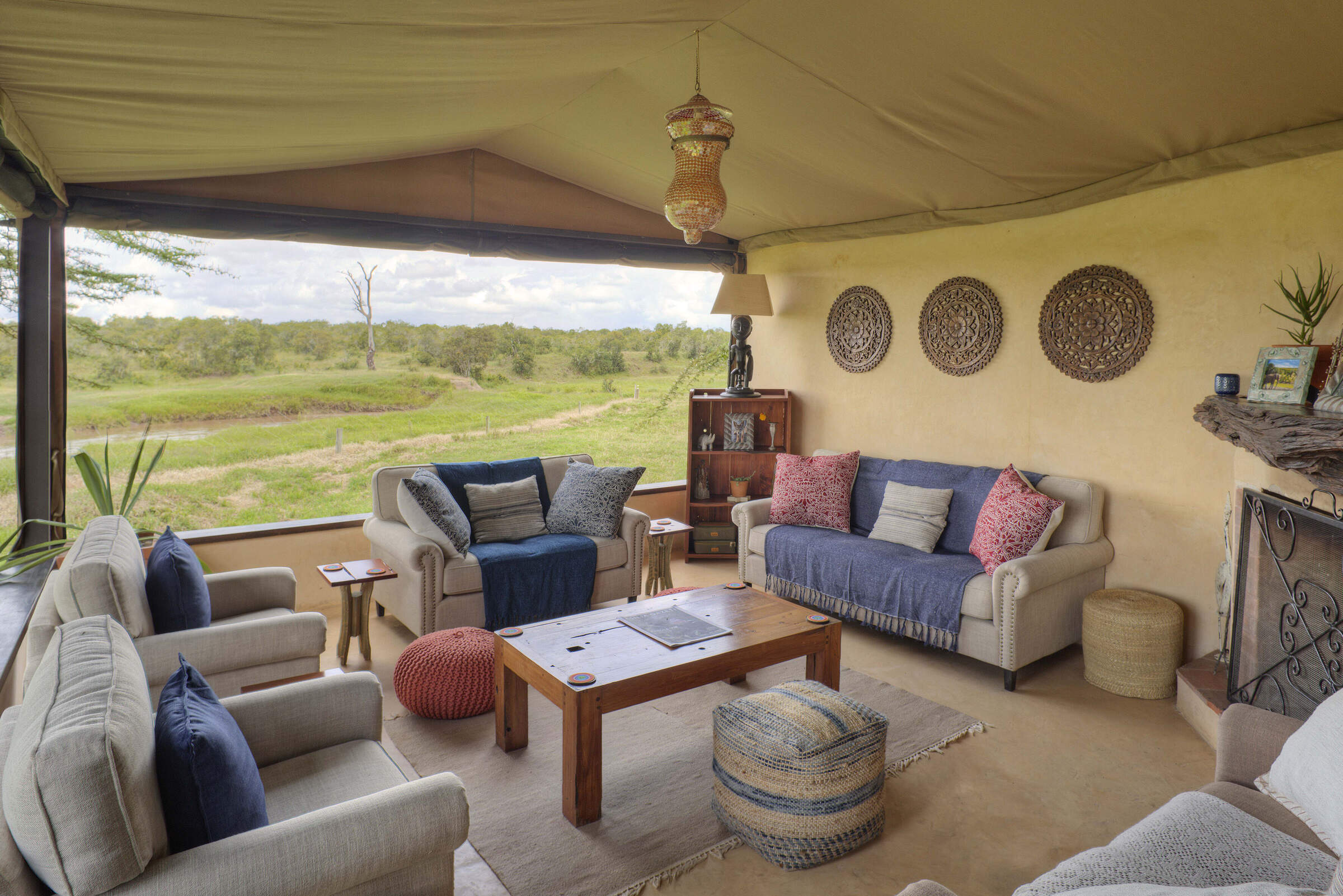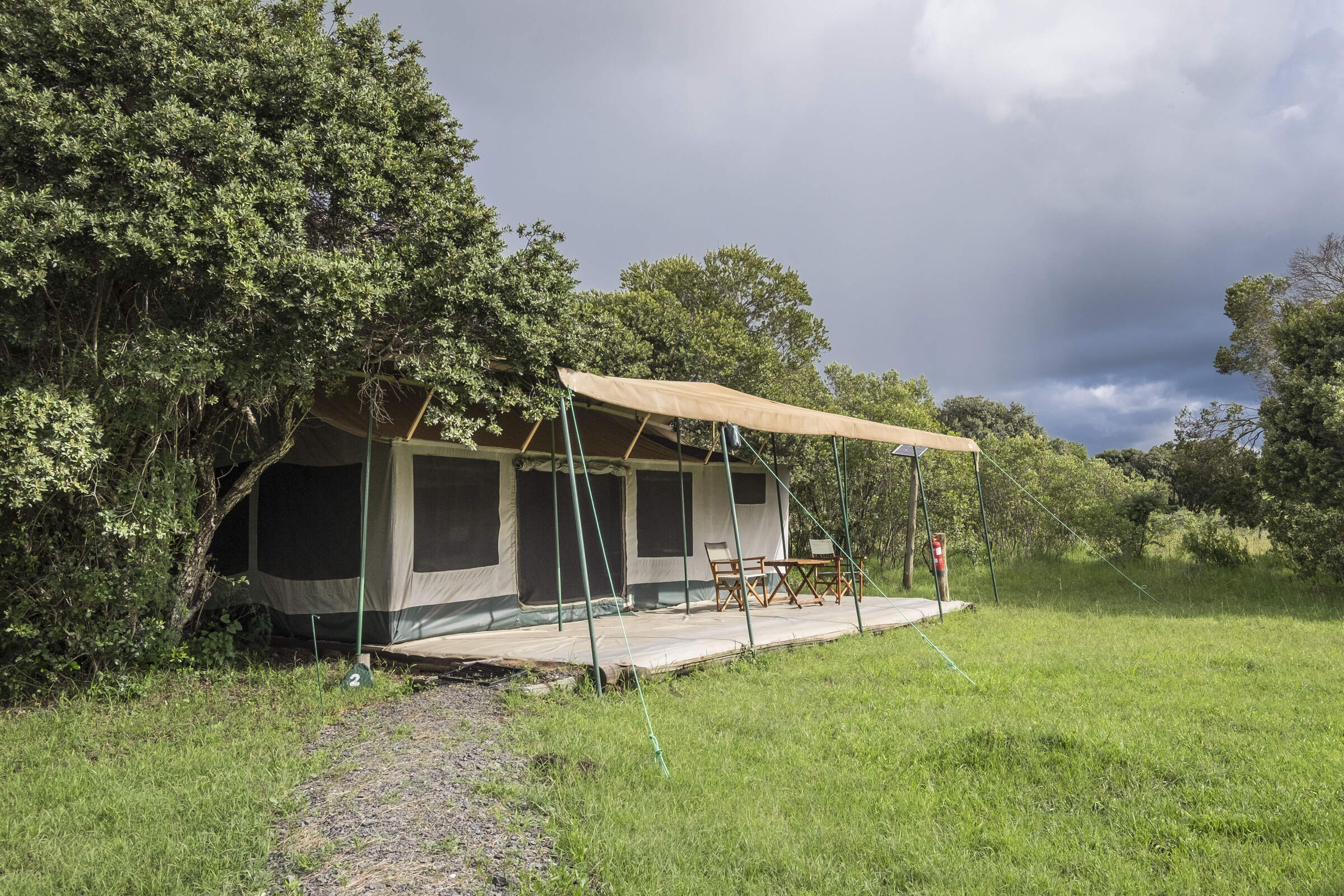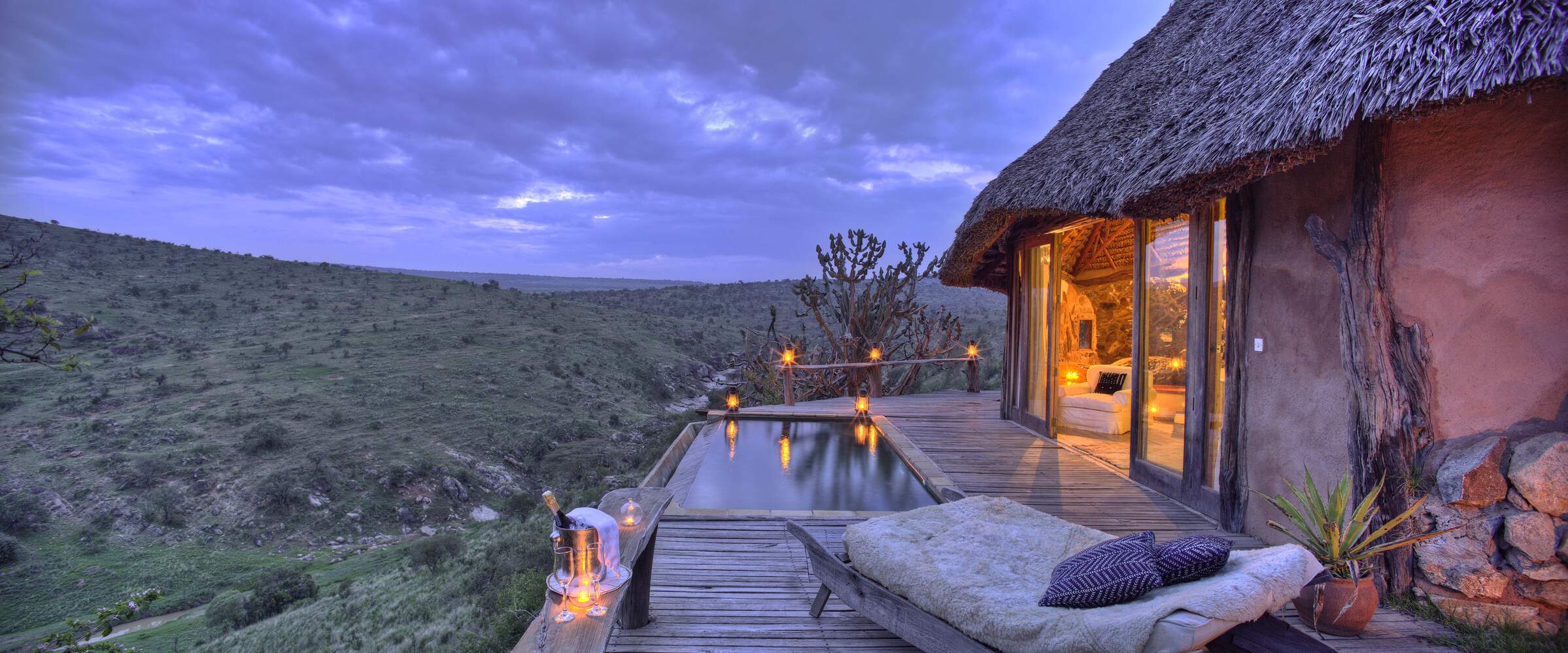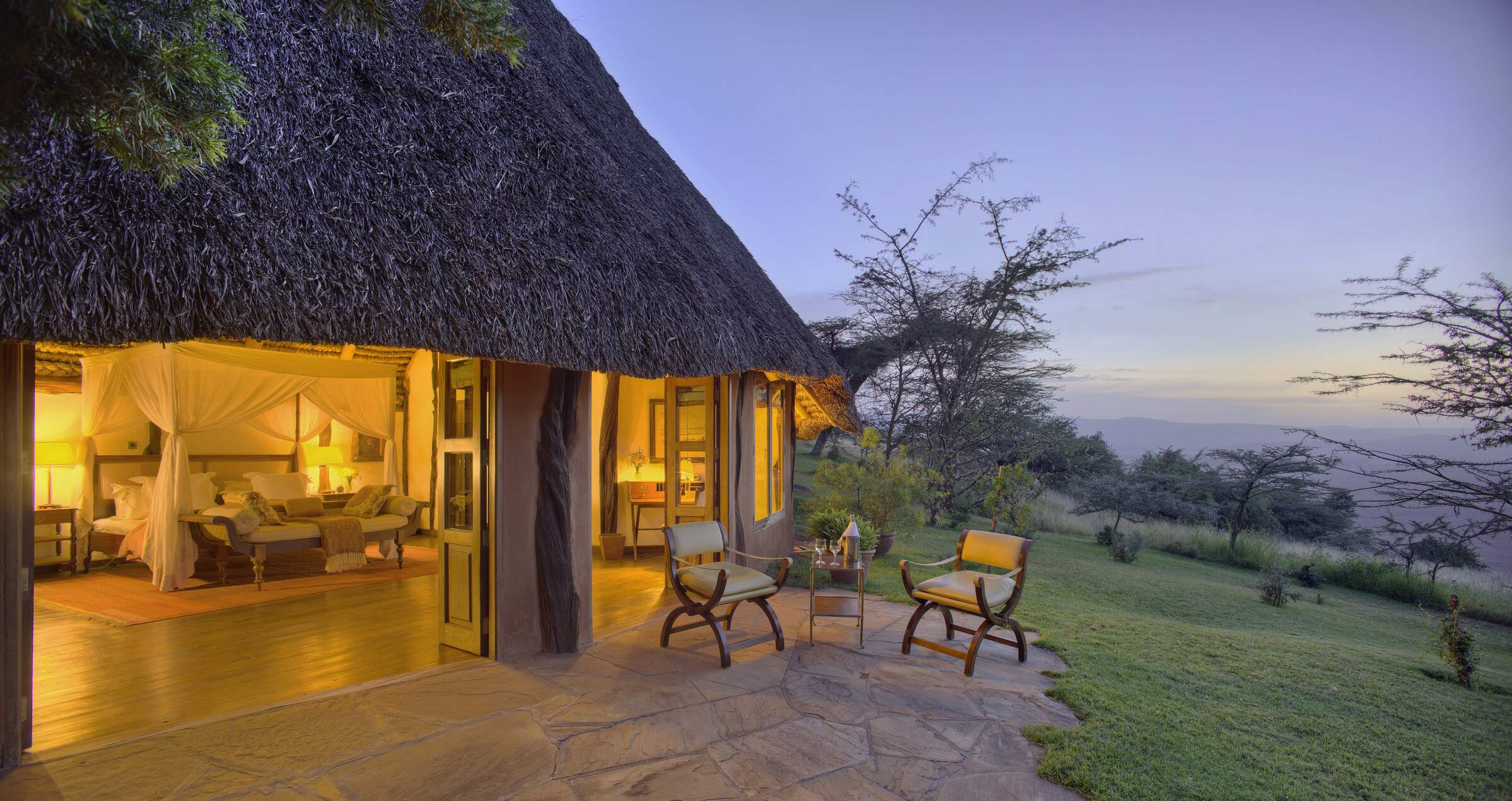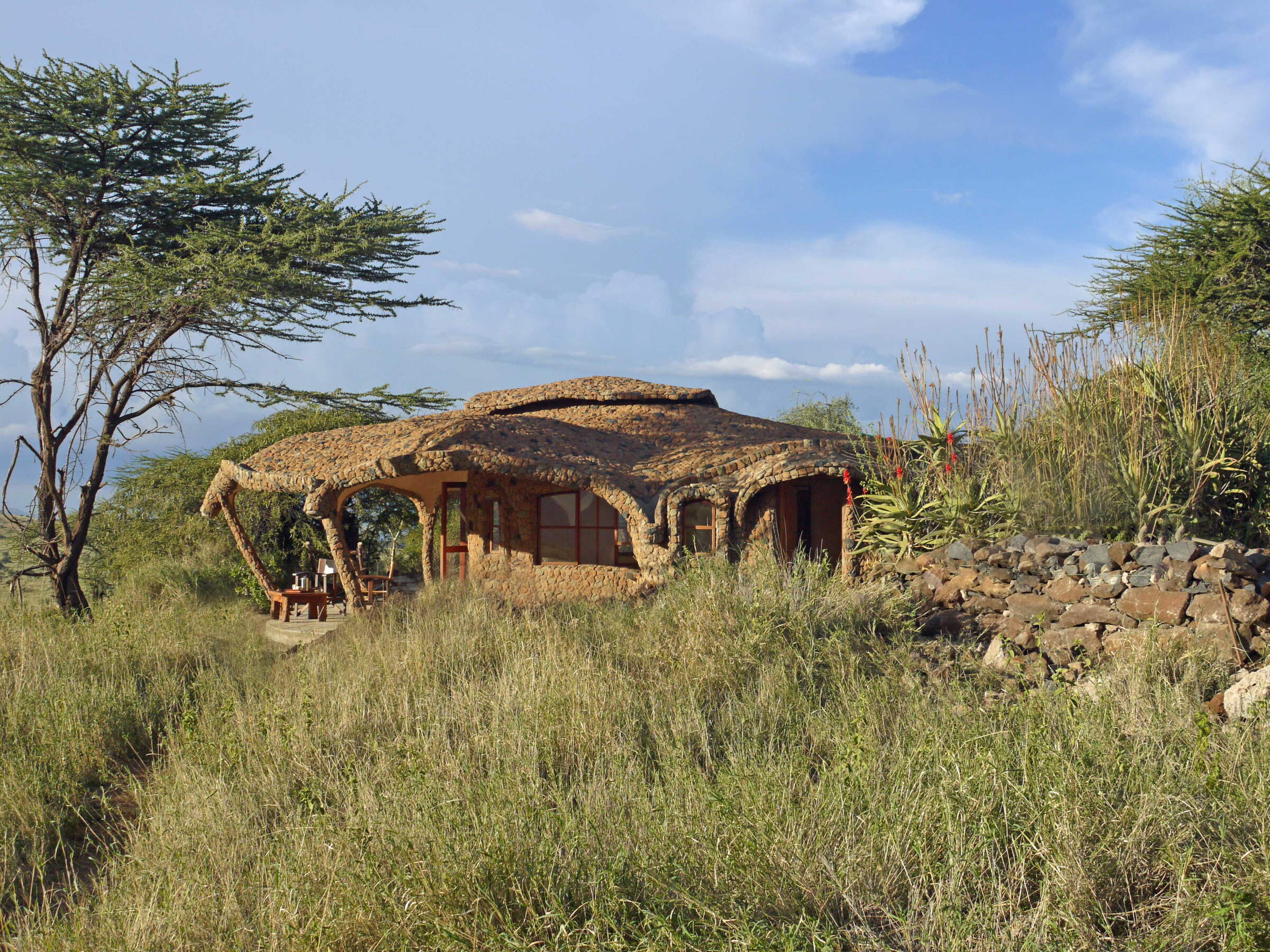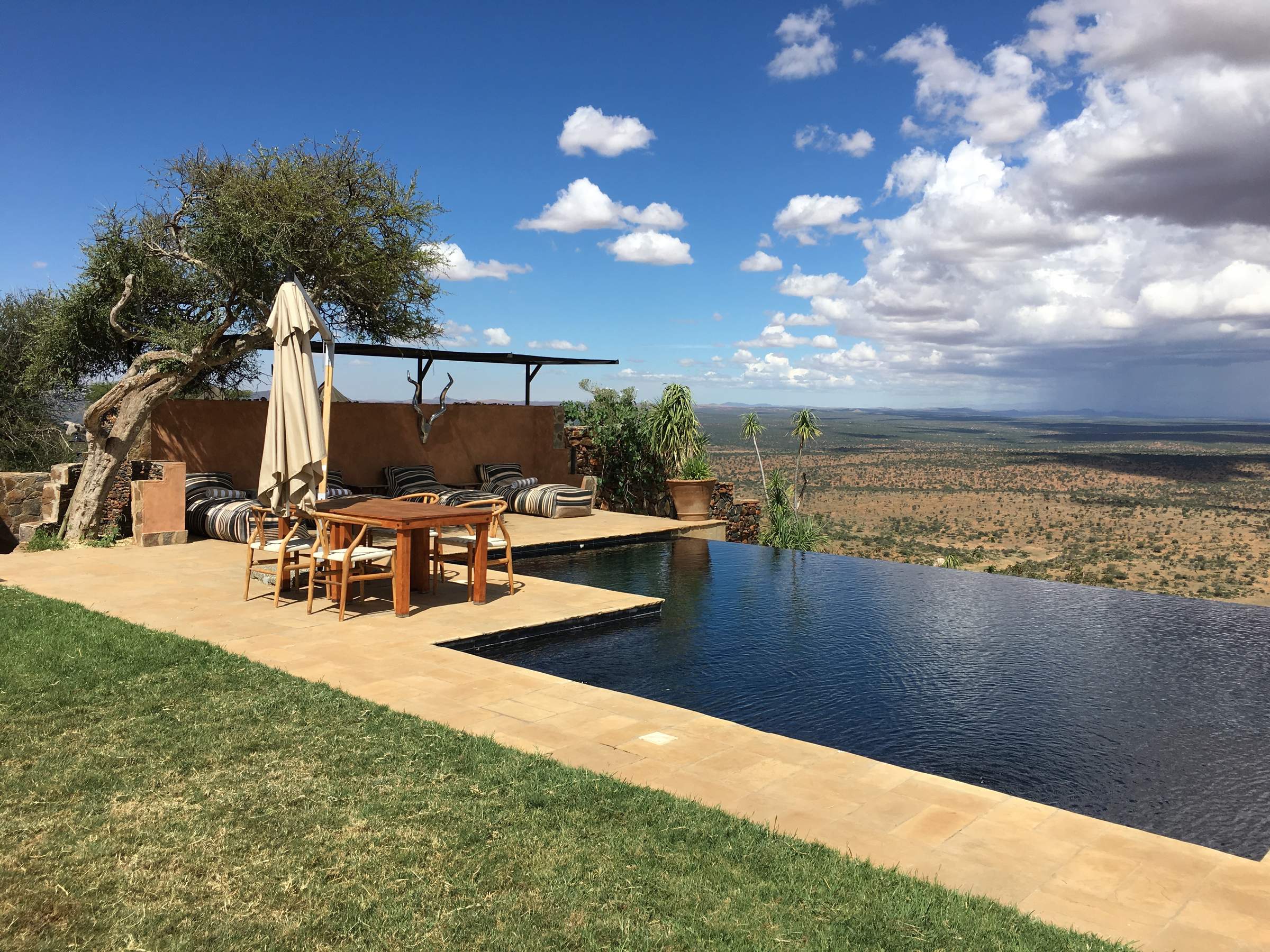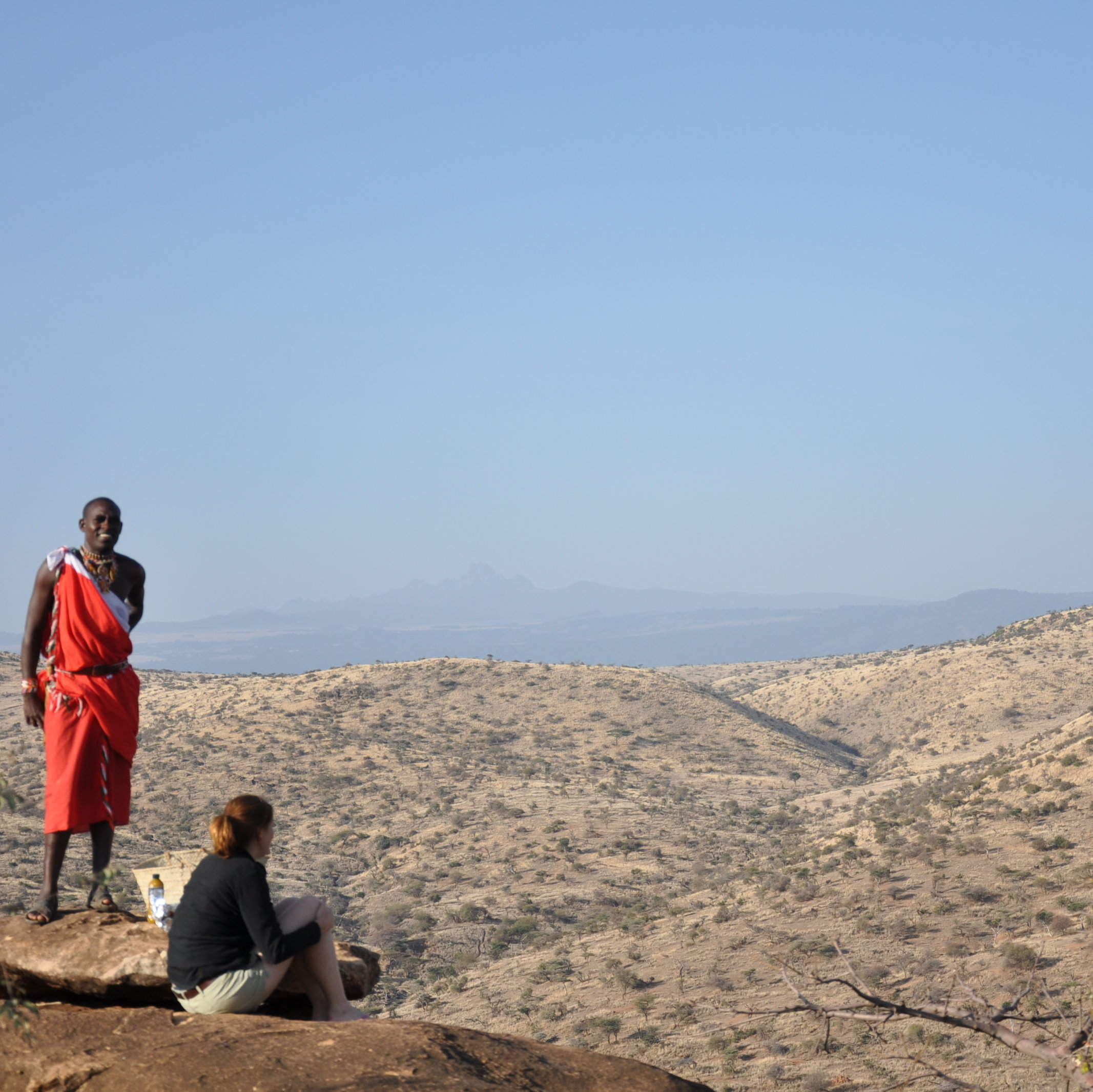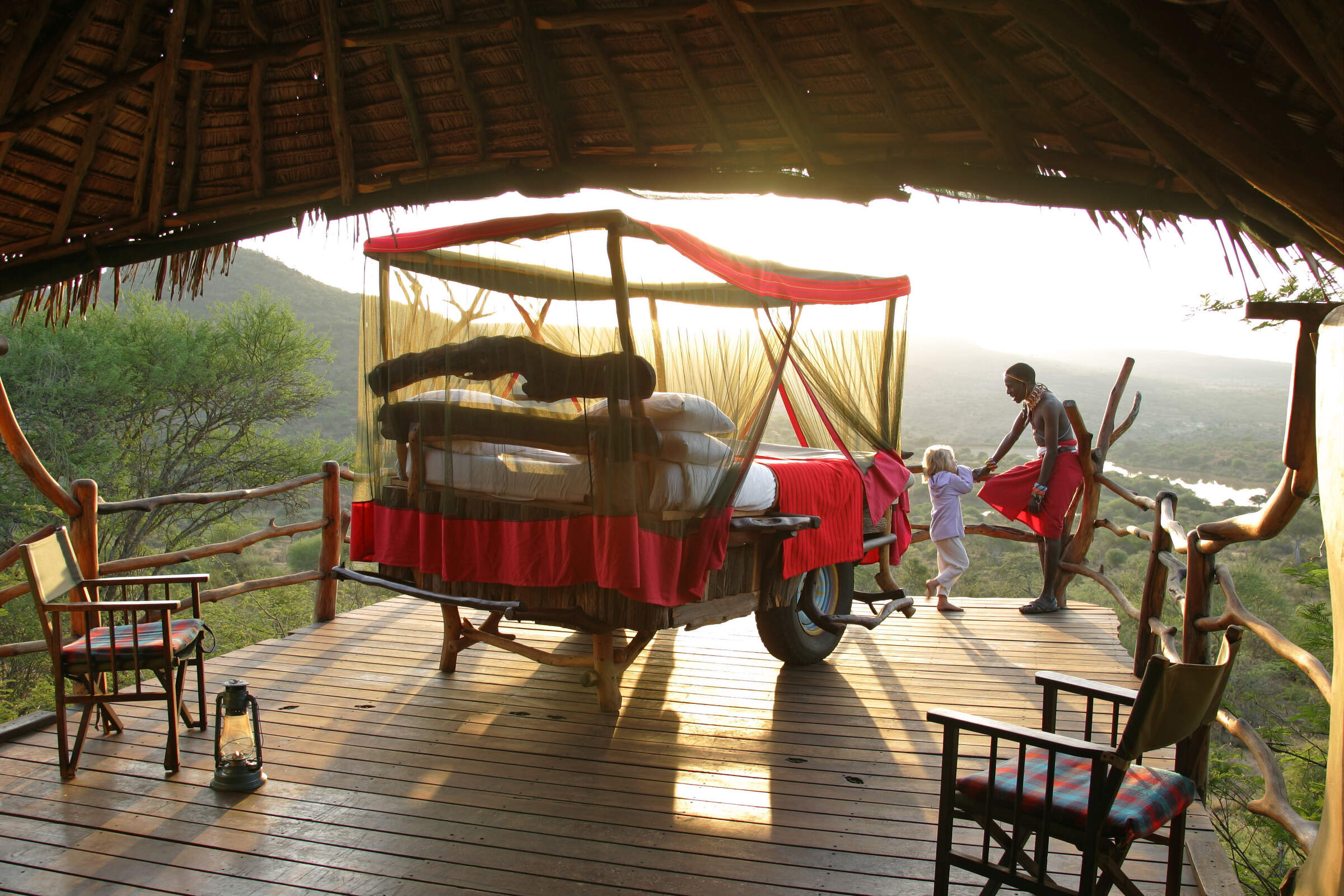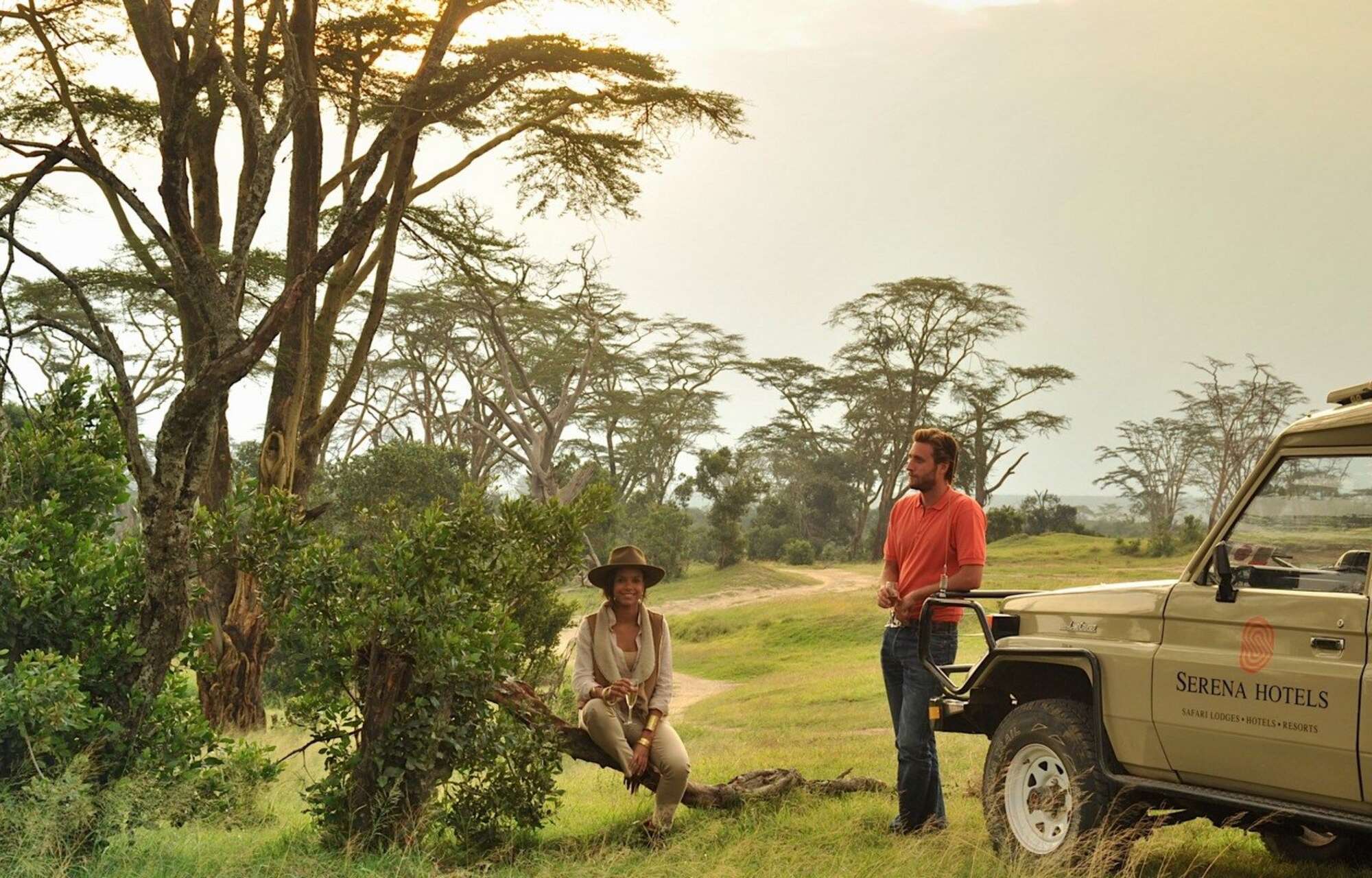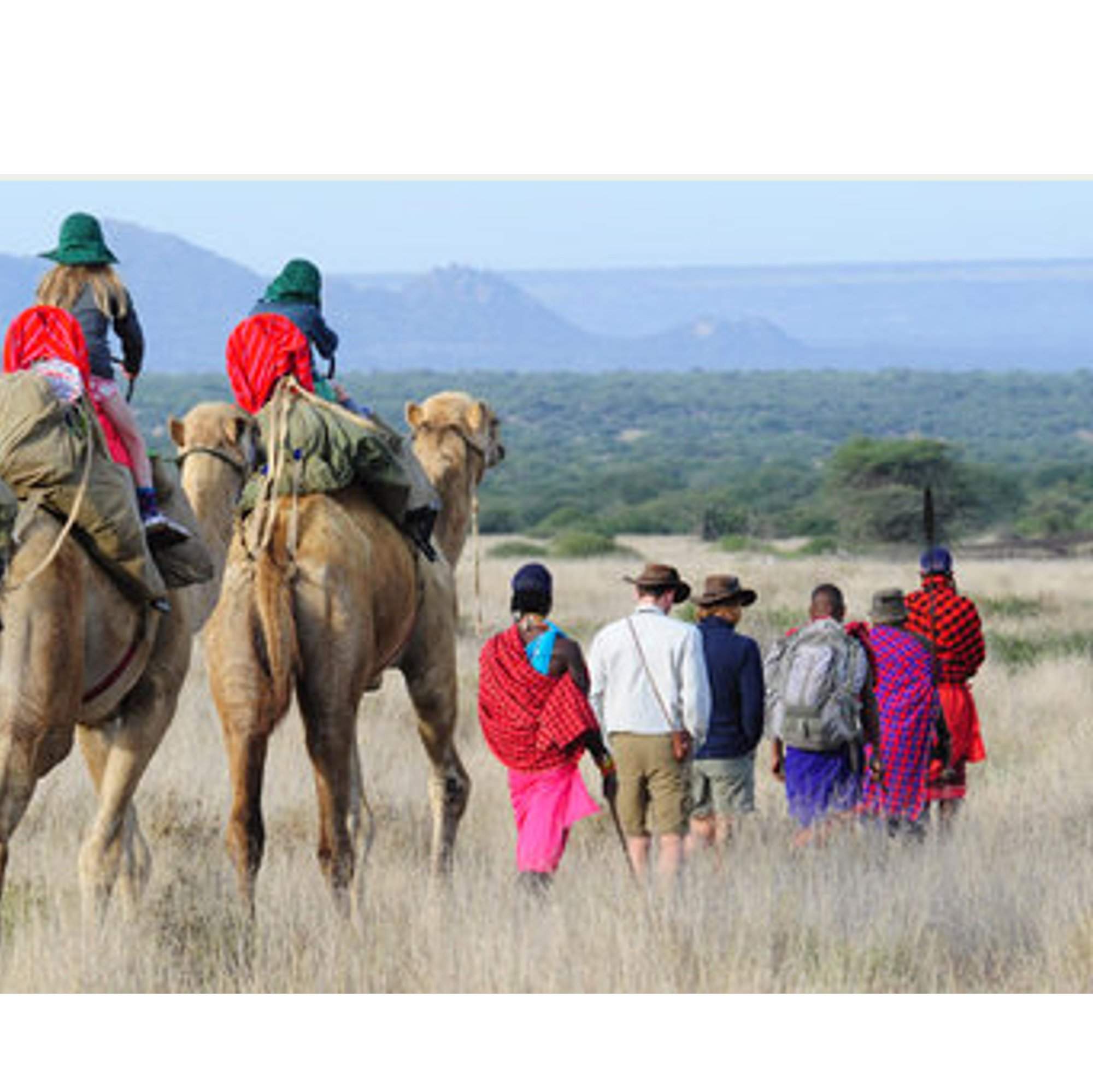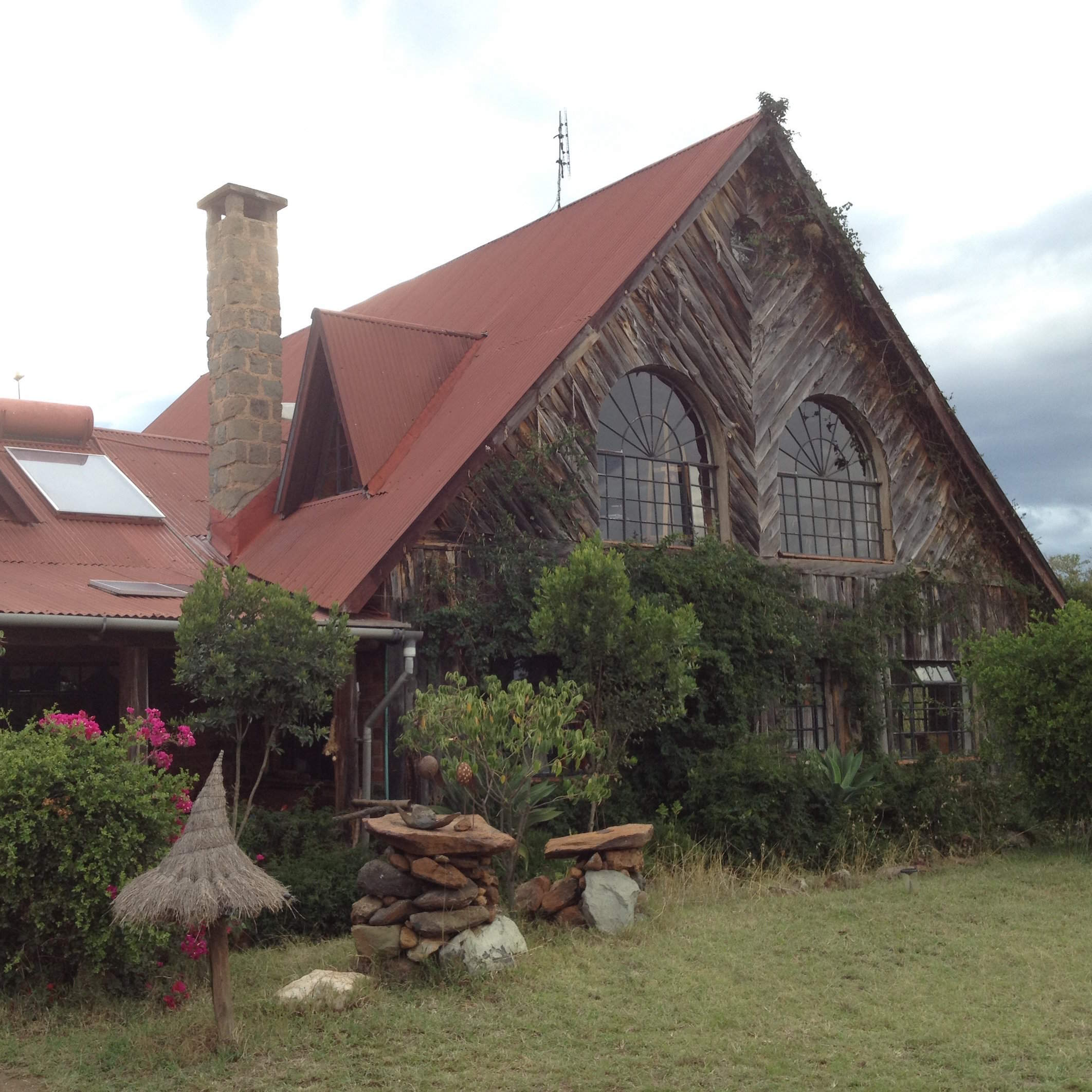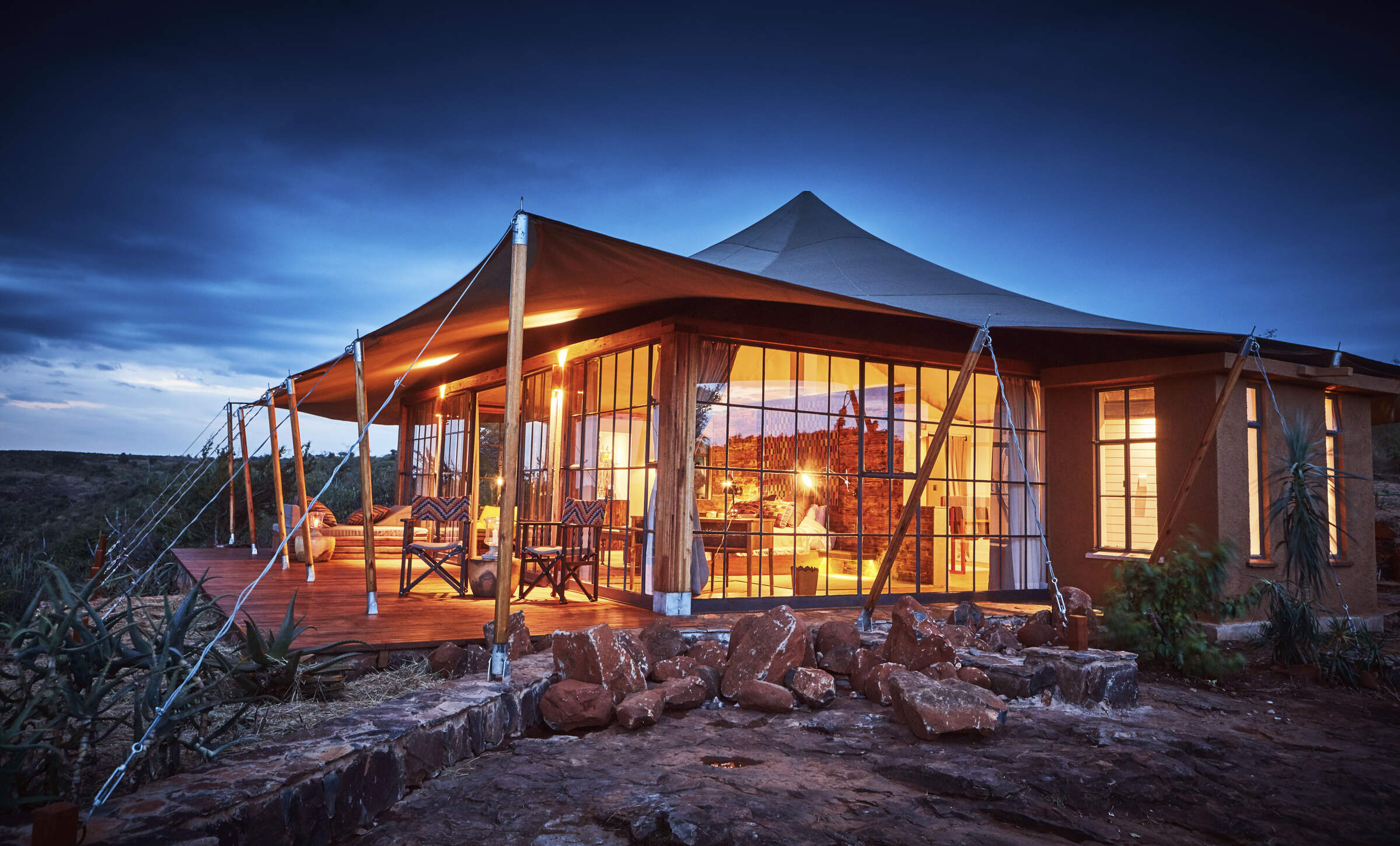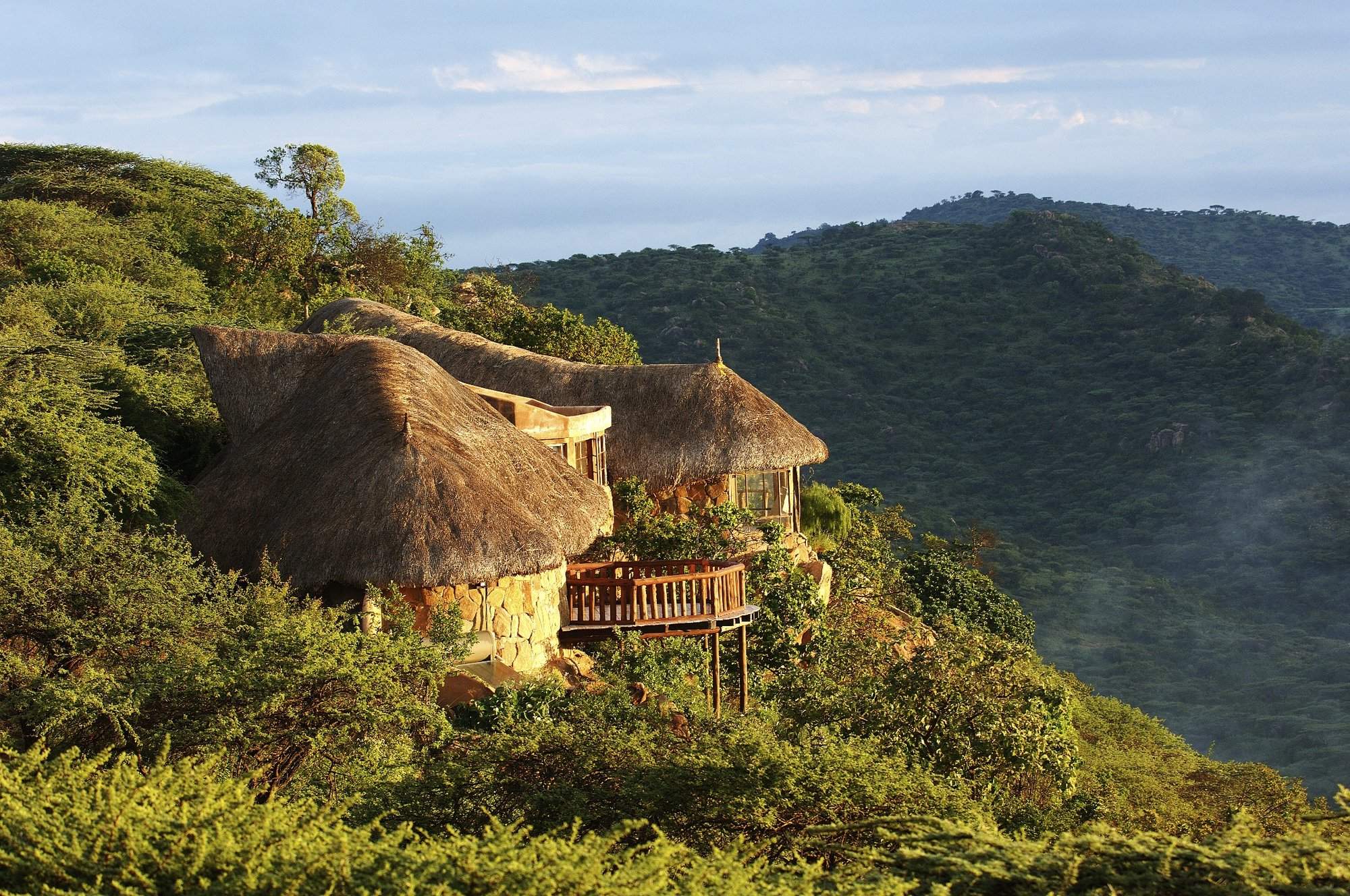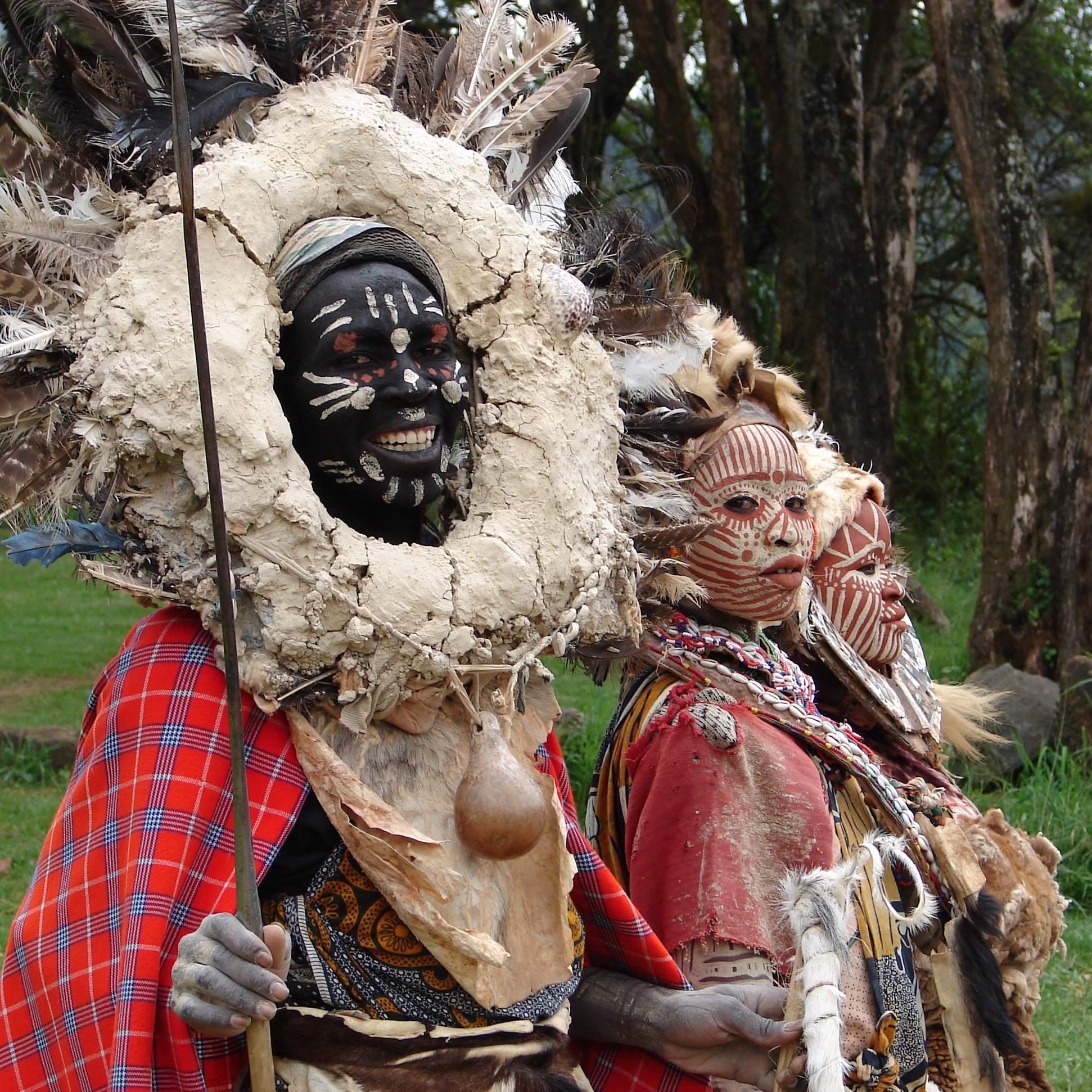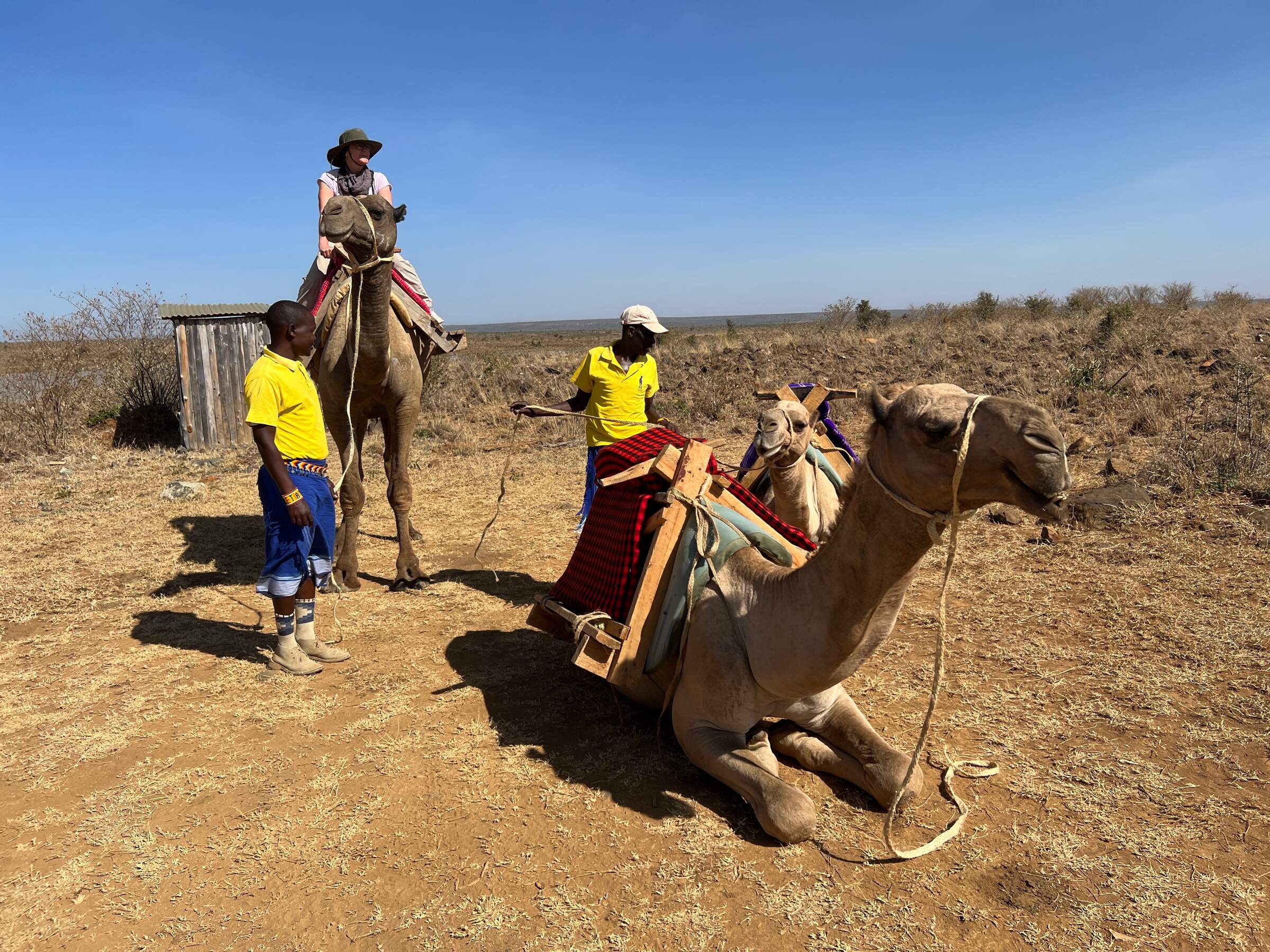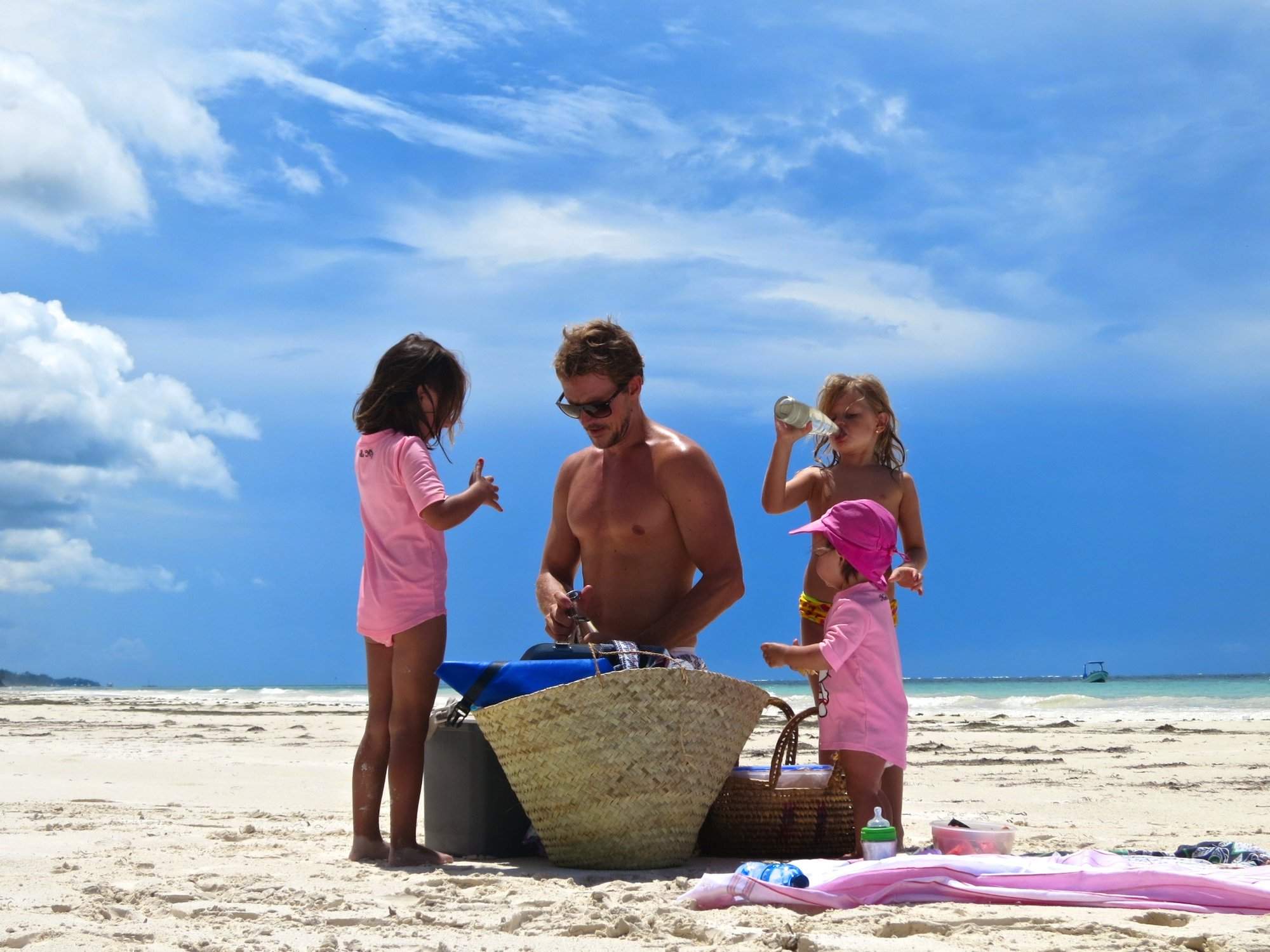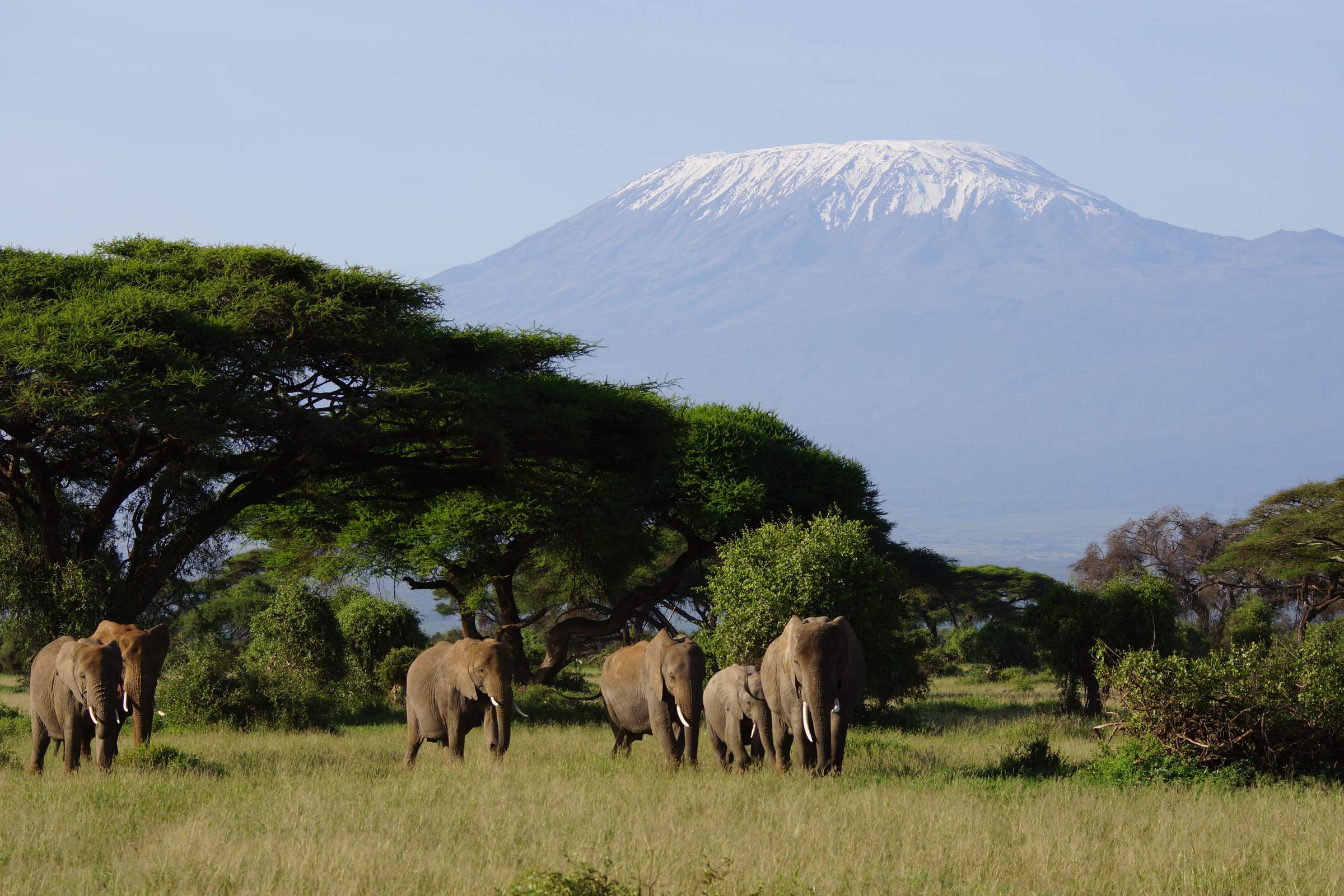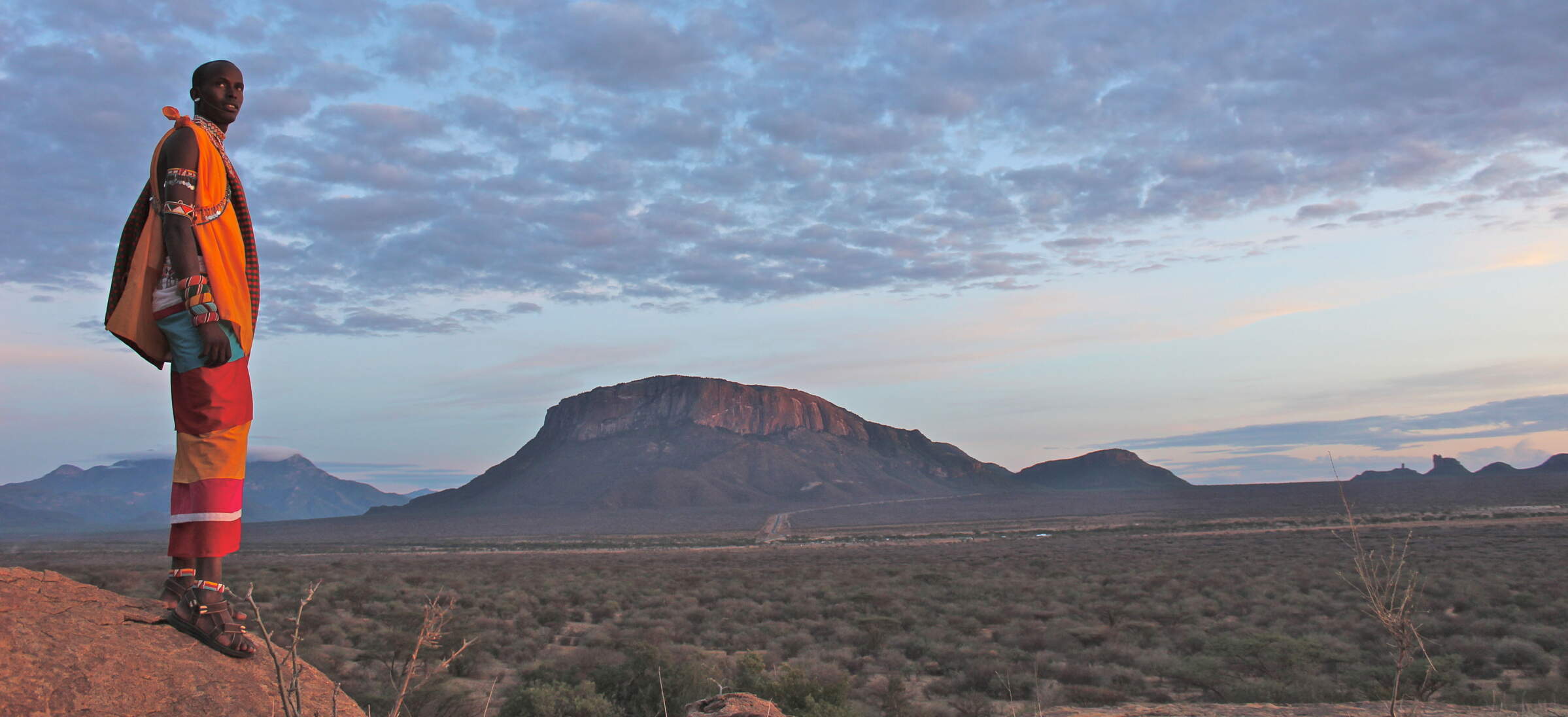Kicheche Laikipia: Our full report
With only six tents, Kicheche Laikipia is a small camp offering comfort and quality, one of a handful of ...
... properties located in the 360km² Ol Pejeta Conservancy. It’s the most luxurious option in the conservancy, with a wide range of activities, and a lovely location, with views across a small dam.Facing the dam, and tucked beneath some shady trees, is Kicheche's spacious main mess tent. The dining area, with a large wooden table, is where breakfast is served, and dinner, too, on cooler nights. Like the rest of the wooden furniture in the camp, the table is beautifully made from cedar wood, which comes from fence posts reclaimed from the conservancy. It is set beside a brick fireplace which makes for a delightfully cosy ambience during dinner on chilly evenings. On warmer days the front of the tent is opened up completely for views of the dam.
The adjoining lounge area is furnished with sofas and armchairs, poufs, and rugs, enhanced by pot plants and vases of locally grown roses. The result is really homely, and this, together with an immensely welcoming team makes the general atmosphere very warm and relaxed.
In a separate tent nearby is a small shop which sells a few locally made items and more sophisticated curios from Nairobi such as belts, bags, and silver jewellery.
- The six tented rooms at Kicheche Laikipia – all named after 19th century Maasai laibon or chiefs – are broadly the same in style, though one is a larger family tent with a double and two single beds. All the tents are raised slightly on solid plinths and are very spacious, with pale cream canvas walls and floors dotted with Persian rugs. Inside, each tent is partially divided by a wood-and-fabric hanging space for clothes. To one side is the bedroom with heavy wooden beds (also made from reclaimed fence posts from the ranch), white linens, and heavy red throws for chilly mornings and evenings, and bright cushions. A sofa and writing desk lie at the foot of the bed, facing the out to the view in front of each tent - perfect for lounging on during siesta time. We especially love how much drinking water is provided at Kicheche camps. Each room is equipped with a large glass barrel from which you can help yourself throughout your stay.
- On the other side of the partition is the bathroom, with a shower, lovely ceramic twin wash basins set on a large wooden vanity cabinet, and a flush toilet behind a separate canvas flap. Water, heated by a solar water heater, is available for use throughout the day and night, although you might need to wait a couple of minutes to allow for the water to warm up as it runs. Shampoo, soap, and shower gel are provided, as is washing powder for ladies to do their own underwear.
- The family tent is larger with two bedroom areas separated by a partition. On one side is a double bed and on the other are twin beds. Both rooms share one bathroom, which is the same as in the other tents.
- Little touches such as wellington boots, umbrellas, insect spray, slippers and a bathrobe, and a yoga mat added to the level of comfort, whilst a bird checklist and maps and information on Ol Pejeta conservancy are provided on the writing desks – we liked the tents here a lot.
- Each tent has a veranda and a hammock at the front with comfy chairs and stylish African-fabric cushions that looks out towards the waterhole. During our stay, a few resident waterbuck seemed permanently positioned in front of our tents, totally uninhibited by our presence, whilst birds and grass mice would move on the lawn.
Kicheche Laikipia Camp has a Gold Level Eco-rating Certificate from Ecotourism Kenya, making it one of only a dozen camps and lodges in the whole country to have achieved this endorsement of its responsible resource use, conservation of the environment and investment in the local community.
In common with all the Kicheche camps (the others are Kicheche Mara Camp, Kicheche Bush Camp and Kicheche Valley Camp) the guides at Kicheche Laikipia all have at least a silver guiding qualification. The activities and wildlife here are really varied: you can do morning, afternoon, or full-day game drives and you can also opt to do a night drive when, if you're lucky, you may see porcupines, civets, zorilla (African polecats) or bushbabies.
For game drives, we found the Kicheche Laikipia vehicles to be some of the best we have used. They now have an all open-sided vehicle fleet with retractable roofs (that can be put back in place in case of rain), and they act as admirable mobile photo hides that are always well positioned by the driver-guides. Bean bags are always available for steadying your camera.
It's also possible to do a walking safari with an armed guide, either in the morning or the afternoon. This normally involves driving out of camp and then walking, as the bush is too thick to walk from camp. A popular option is to do this in the morning when you have a good chance of seeing the more elusive black rhinos for which the Ol Pejeta Conservancy is famous, as well as the much less skittish white rhinos which are happy to graze on the open plains.
Subject to the water level, you can also canoe on the dam lake in front of camp, or set out for a cycle ride one of the camp's mountain bikes. For a bike ride, guests are first driven to the southern part of the conservancy which is regarded by Kicheche Laikipia as being free of dangerous wildlife. Note, however, that Expert Africa does not recommend doing activities that take place outside of a vehicle without an armed escort.
Kicheche Laikipia has recently introduced fly-camping, at extra cost, which is led by an experienced walking guide. Setting off in the afternoon, you drive to the neighbouring conservancy of Loldaiga before walking a couple of hours to the fly-camp. After dinner you bed down for the night in small dome tents surrounded by the sounds of the African bush. The following morning you can either embark on a longer 13km walk back to the main camp or take a vehicle and go on a slow game drive.
Full-day visits to the Ngare Ndare forest, in the northern foothills of Mount Kenya, are also possible at extra cost. As well as walking in this indigenous, highland forest, you can visit the tree-level canopy walk for a bird's eye view and go swimming in the waterfalls. It's worth noting that it takes around 1hr 45 - 2hr to drive to Ngare Ndare forest, and the same back, but for those who would like to be active in a verdant ecosystem, we think this makes for a great activity.
Another popular activity is to visit the anti-poaching dog unit (extra cost) which is incredibly interactive and fun. These are working dogs, so it's best to talk to the camp manager upon arrival to confirm availability and arrange a visit - and be sure to wear clothes you don't mind getting muddy. The bloodhounds are friendly and won't be shy about jumping up to give you a lick (as these are big, heavy dogs, it's worth noting this activity is best suited to those comfortable with being jostled a bit by large, friendly dogs).
For many people, an absolute must at Ol Pejeta Conservancy is a visit to the Northern White Rhino Sanctuary, which is home to the last two remaining females. This needs to be booked in advance and costs US$60 per person. Guests will greet a keeper and pass Baracka (the resident blind black rhino) en route to the white rhino enclosure. It's very likely that the keeper will call Baracka over to the fence line for you to give him a rub and a scratch and take a photo, too. Guests are then driven into the enclosure with the ladies, Fatu and Najin, where a ranger feeds the rhinos and talks to you about the sanctuary's progress in attempting to breed this magnificent and critically rare subspecies. Whilst it is believed that only two females remain, scientists are attempting to use IVF technology with existing biological samples to create an embryo which will then be carried by a surrogate southern white rhino female.
Ol Pejeta also has a chimpanzee refuge, which you can visit free of charge. Some visitors may enjoy this experience, though it is not for everyone. The 1km² sanctuary provides a semi-wild fenced environment for chimps from the Jane Goodall Institute in Burundi, and confiscated pets and bushmeat-trade orphans from other parts of Africa, which cannot be reintroduced into the wild. Chimpanzees are not native to Kenya, and as a welfare home (females receive contraceptive medication) the sanctuary does not serve any conservation purpose, however, it does focus visitors' attention on the perilous status of wild chimpanzees. On a free visit, you view the chimps from behind the fence of their enclosure. You can also visit behind the scenes (extra cost) to see them being fed, chat to the rangers, and learn about individual chimps and their histories.
Our view
Kicheche Laikipia is very comfortable and offers space and luxury, but with a tastefully rustic edge. The welcoming managers, friendly staff and communal dining all combine to make this a sociable and relaxed camp. The end result is luxury, but with a total lack of pretension, and all of that would add up to a very fine place to stay. However, the camp's eco credentials and its very high standards of guiding make it one of the best in northern Kenya.
Geographics
- Location
- Laikipia, Kenya
- Ideal length of stay
- Two to three nights at least to explore the conservancy properly. If you want to try the full range of activities, it would be easy to stay here for four nights.
- Directions
- Visitors to Kicheche Laikipia fly from Wilson Airport in Nairobi to Nanyuki Kamok, taking from 40 minutes direct to a couple of hours if you fly via Samburu. It is then 15-20 minute direct transfer to camp, but you'll often pause to watch wildlife.
- Accessible by
- Fly-and-Transfer
Food & drink
- Usual board basis
- Full Board & Activities
- Food quality
- We have stayed at Kicheche Laikipia on numerous occasions over the years, and always found the food to be very good. There is an abundance of nearby farms producing fresh produce and there is no lack of tasty salads and vegetables. The camp has its own vegetable and herb garden, and lamb and beef comes straight from the livestock on the mixed-use Ol Pejeta Conservancy itself. All the Kicheche camps do things differently, so if you are staying in more than one, you won't find yourself eating the same menu twice. Kicheche Laikipia is particularly flexible to guests' requirements and preferences.
Breakfast is often taken out of camp as a picnic, and usually consists of fresh fruit, bread, sausages, bacon and eggs all pre-prepared at the camp. Hot tea and coffee is on offer as are juices. In camp, breakfast is a selection of fruit, cereals and a cooked breakfast to order.
Weather permitting, lunch is served al fresco. It is often taken out as a picnic, but on our recent visit we had lunch in camp which was set up overlooking the dam. We had gnocchi and herby tomato sauce to start, followed by vegetable quiche and a selection of fresh salads, cheeses and breads. Desert was a pineapple crumble.
Tea is served before the afternoon activity with the option of coffee, tea or herbal tea – and homemade cake.
Dinner is three courses, usually served in the dining room beside the fire. On our most recent visit we started with pumpkin and orange soup, then an East African buffet which consisted of a medley of curries, rice, dahl and traditional Kenyan dishes. We rounded up the meal with a rich white chocolate mousse. On a previous stay we’ve enjoyed a Mongolian barbecue, which was really fun and interactive. - Dining style
- Mixture of group dining and individual tables
- Dining locations
- Indoor and Outdoor Dining
- Further dining info, including room service
- Kicheche Laikipia can offer dining in tents on request, but this has to be arranged in advance. The radios in the room are for emergencies as opposed to room service.
- Drinks included
- All available drinks are included in the price, including house wines, beers, and spirits. Many of the wine bottles are recycled into the drinking glasses used at camp, and there is a beautiful bathroom made from recycled wine bottles at the back of house.
Special interests
- Solo Travel
- See ideas for Solo Travel in Kenya
- Walking safaris
- Kicheche Laikipia’s guides are all at least silver-qualified. Their insights into local flora and fauna contribute hugely to the walking experience, while opportunities to explore the conservancy on foot provide sightings of black and white rhinos.
- See ideas for Walking safaris in Kenya
Children
- Attitude towards children
- Kicheche Laikipia accepts children but considers that children over the age of six years are better suited to the camp.
- Property’s age restrictions
- None
- Special activities & services
- Kicheche Laikipia has a family tent, and can provide a night guard outside the tent for children who go to bed early. The camp can offer children's meals in the tents at an earlier time. They don't offer childminding but do have board games. They also have guided daytime activities for children, including: tracking animal footprints around camp and identifying bones; catching, releasing, and identifying butterflies and other insects; making bows and arrows and learning how to throw a spear.
- Equipment
- None
- Generally recommended for children
- Though the camp is fenced it is in a wild location with a lot of dangerous game. We would recommend Kicheche Laikipia only for older children and teenagers who can be trusted to behave appropriately in an area like this.
- Notes
- Children are their parents’ responsibility at all times.
Our travellers’ wildlife sightings from Kicheche Laikipia
Since mid-2018, many of our travellers who stayed at Kicheche Laikipia have kindly recorded their wildlife sightings and shared them with us. The results are below. Click an animal to see more, and here to see more on our methodology.

100% success

100% success

100% success

100% success

100% success

100% success

100% success

98% success

87% success

61% success

26% success

17% success

17% success

14% success

2% success

0% success
Communications
- Power supply notes
- There is a backup 5KVA generator. There are plugs for charging batteries in all of the tents 24/7. The tents have plenty of well positioned lighting.
- Communications
- Kicheche Laikipia has WiFi in the guest rooms but not in the communal area; there is intermittent cellphone coverage.
- TV & radio
- None
- Water supply
- Borehole
- Water supply notes
- There is a pipeline from the the Ol Pejeta Conservancy borehole to two 5000-litre water tanks. They also harvest rain water. Large, 20-litre water barrels are split into game-drive water flasks and clay urns in the tents that keep the water cool.
Sustainability

Kicheche:The game-changer of community development
Comprising of six luxurious tents, Kicheche Laikipia Camp is located in Ol Pejeta Conservancy, home to Kenya’s largest population of Black Rhino. The application of responsible tourism practices to support community development through education has put Kicheche Laikipia Camp on the map as one of the best tourism facilities in Kenya.
Education initiatives engage locals and tourists alike. The camp has an in-house staff training program whereby employees are trained on issues such as conservation and health and safety. Chefs receive refresher training at Kenya Utalii College, whereas the camp guides are certified under the Kenya Professional Safari Guides Association. Each year the camp sponsors students at the Koiyaki guiding school, and currently employs several graduates as guides.
Kicheche Laikipia also implements educational initiatives through Kicheche Community Trust. Proceeds from the camp through the Trust are used to support schools, providing bursaries for children in need or those affected by HIV/AIDS. Kicheche Laikipia Camp is especially involved in supporting Nanyuki Children’s home, engaging in self-empowerment project (i.e. farming layers hens) and increasing awareness about urgent needs such as bursaries to pay for school fees & uniforms.
Guests are also encouraged to get involved in providing quality education for the local community through the worldwide ‘Pack for a Purpose’ initiative, which asks tourists to donate items that may be of need in their areas of travel. To this extent, Kicheche Laikipia actively promotes the ‘Go buy a book’ programme, asking tourists to pack a book and donate it to a local youth center.
Consistent efforts towards local community development have brought the camp the Gold level Eco-rating Certification by Ecotourism Kenya for their outstanding and replicable best practices.
See more great sustainability projects in Kenya
Health & safety
- Malarial protection recommended
- Yes
- Medical care
- There is first-aid equipment in camp and also in the vehicles, and guides are all trained in basic first-aid and do yearly refreshers. Nanyuki Cottage Hospital is an hour's drive away.
For emergencies, Kicheche Laikipia has contact with flying doctors; the nearest airstrip, Kamok, for charter flights and emergencies only, is ten minutes' drive away. - Dangerous animals
- High Risk
- Security measures
- There is a central safe in camp and there are green storage bags in the tents for valuables. Askaris escort guests around the camp at night. A discreet, two-wire electric fence encloses the total camp concession of around 20 acres (8 hectares). However, the fence isn't a guarantee of a megafauna-free zone and the list of uninvited guests is impressive: buffalos, waterbuck, leopards, hyenas and lions have all entered the camp at one time or another.
- Fire safety
- Kicheche Laikipia has fire extinguishers in the main areas and by each tent and does regular staff training on how to use them. They also have a fire meeting point and a fire-break around the camp with the dam at the front of camp and a road at the back.
Activities
4WD Safari
Birdwatching
Canoeing
Guided walking safari
Mountain biking
Night drive
Private activities
Extras
- Disabled access
- On Request
- Laundry facilities
- Laundry service is included, but female underwear isn't accepted, so guests are invited to wash their own underwear with the soap powder provided. Laundry is hand washed and line dried.
- Money
- No exchange facility is available at Kicheche Laikipia.
- Accepted payment on location
- Kicheche Laikipia accepts Visa, Mastercard and Amex with a 5% surcharge. Cash is accepted in euros, US dollars, British pounds, and Kenyan shillings. Staff gratuities can be made in cash or via credit card.
Other lodges in Laikipia
Alternative places to stay in this same area.

